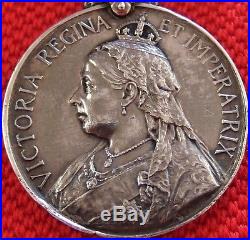
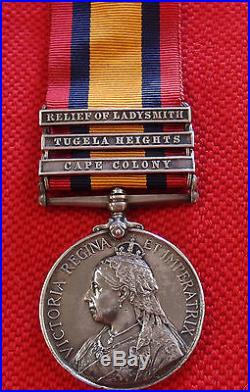
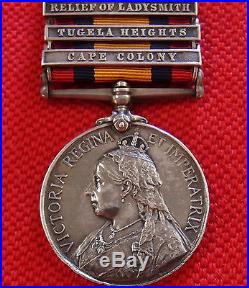
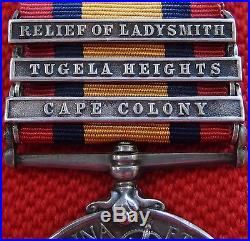
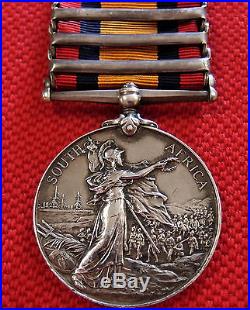
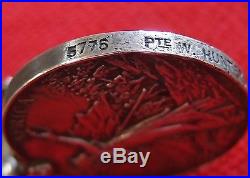
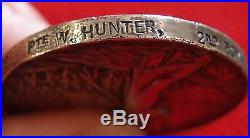
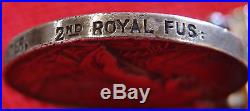
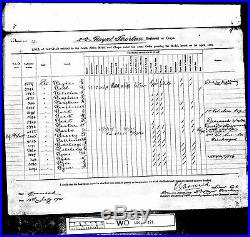
Boer War Queens South Africa Medal to Private Hunter, who served with the 2nd Battalion (City of London Regiment) Royal Fusiliers, who died of Enteric Fever on the 6th April 1900 at Modder Spruit. Queen’s South Africa Medal measures 36mm wide and is a circular silver medal with claw and swivel ribbon bar suspension, with CAPE COLONY, TUGELA HEIGHTS & RELIEF OF LADYSMITH clasps; the face with the veiled crowned head and shoulders portrait of Queen Victoria facing left, circumscribed VICTORIA REGINA ET IMPERATRIX (Victoria Queen and Empress), signed G. De Saulles; officially re – impressed named to 5776 PTE W. HUNTER, 2ND ROYAL FUS: on correct ribbon. The medal was instituted in 1899 to be awarded to participants in the Boer War. The medal roll for the 2nd Battalion shows Hunter as having died on the 6th April 1900, with further research showing he died of Enteric Fever at Modder Spruit. Royal Fusiliers (City of London Regiment). The 2nd Battalion sailed from Gibraltar on the Pavonia, arrived at the Cape about 18th November 1899, and was at once sent round to Durban. Along with the 2nd Royal Scots Fusiliers, 1st Royal Welsh Fusiliers, and 2nd Royal Irish Fusiliers, they formed the 6th or Fusilier Brigade under Major General Barton, which was originally intended to be part of the IIIrd Division under General Gatacre, but the stress of events necessitated the breaking up of that division. The brigade was present at Colenso and formed the right of the infantry advance, otherwise the flank nearest to Hlangwane Mountain. A sketch of the Colenso action and of the doings of the Natal Army generally is given under 2nd Royal West Surrey. It appears from the orders issued by General Clery on the 14th December that General Buller and he had not quite made up their minds whether Hlangwane would be attacked or left alone. Colonial Irregulars did make some advance up its steep sides, but they were not supported. In his despatch of 17th December General Buller says, “The mounted troops under Lord Dundonald, supported by two guns of the 7th Battery RFA and two battalions 6th Brigade, were heavily engaged with a considerable force that attacked my right flank, and which they repulsed”. Unofficial accounts rather give one the impression that the attack was by the British, and that, perhaps because of the gun entanglement, it was not pushed home. According to Mr Bennet Burleigh (p 217), the Royal Fusiliers were on the extreme right. As they had almost no losses they could not have been heavily engaged. The Royal Scots Fusiliers suffered considerably, but they are stated by Mr Bennet Burleigh (p 203) to have been on Barton’s left, nearest Colenso, and not far from the lost guns. When General Buller moved west towards the Upper Tugela, about 9th January, General Barton was left to guard the rail-head at Chieveley, and with his small force made various demonstrations to keep the enemy at Colenso. At the end of January a portion of the brigade, including the Royal Scots Fusiliers, was taken to the main army. When Sir Redvers Buller had come back to Chieveley, and determined to make a fourth attempt via the Boer left, the Fusilier Brigade were the first infantry employed. On 12th February Lord Dundonald seized Hussar Hill, his force being the South African Light Horse, Composite Mounted Infantry, Thorneycroft’s Mounted Infantry (or what was left of them after Spion Kop), the Royal Welsh Fusiliers, a battery of Colt guns, and a battery RFA. The hill was taken for the purpose of reconnaissance only, and the force retired, having a few casualties in that process. On the 14th the hill was again taken and occupied, the Welsh Fusiliers being the first infantry regiment and the Fusilier Brigade being part of the garrison of the hill. The brigade took part in practically all the fighting between the 14th and 27th. On the 17th the Welsh and Irish took part in an attack on Greenhill, which was not pressed. Next day “General Warren, throwing the 6th Brigade forward, the position [Greenhill] was well carried by the Royal Scots Fusiliers and abandoned precipitately by the enemy, who left a large quantity of materiel, many dead and wounded, and a few prisoners behind them”. On the 19th the brigade took Hlangwane. On the 24th the battalion, along with the Royal Welsh Fusiliers, was holding some kopjes near Langerwachte, where they had to lie under heavy shell and rifle fire. In the final assault on the Boer position on 27th February General Barton’s task was to take Pieter’s Hill. His force that day was the Royal Irish, Royal Scots, and Royal Dublin Fusiliers, and right well did they carry out their mission. Had that assault miscarried the remainder of the operations would have been at a standstill. On the fourteen days’ fighting the battalion’s losses were 1 officer and 3 men killed, 4 officers and 70 men wounded. One officer and 10 non-commissioned officers and men were mentioned by General Buller in his despatch of 30th March, of the latter being recommended for the distinguished conduct medal. After the relief of Ladysmith the 5th and 6th Brigades, now called the Xth Division, were placed under Lieutenant General A Hunter, and in preparation for the relief of Mafeking and the occupation of the Western Transvaal the Division was brought round to Cape Colony. The 5th Brigade, still under Major General Fitzroy Hart, was utilised to assist in the relief of Wepener, which was effected on 24th April. In the meantime the 6th Brigade had been gathering at Kimberley, and on 5th May General Hunter attacked and defeated the enemy at Rooidam, west of the Kimberley-Warrenton line, the Fusilier Brigade having all the work. The battle of Rooidam enabled the Mafeking relief column to get a clear start. The column comprised four guns M Battery RHA, two pom-poms, the Kimberley Mounted Corps, the Imperial Light Horse, and an infantry company made up of four sections specially selected from each of the four battalions in the Fusilier Brigade. Under the very skilful leadership of Colonel Mahon the column joined hands with Plumer on 15th May, the enemy was defeated on the 16th, and Mafeking entered on the 17th. General Hunter, having been joined by Hart, occupied Lichtenburg on 2nd June, Klerksdorp on 9th June, and he marched thence and arrived at Johannesburg on 22nd June, and joined hands with Clery and the old Natal comrades at Vlakfontein on the Natal-Johannesburg Railway on 5th July. About the 21st June the Fusilier Brigade was split up. General Barton remained with the 2nd Royal Scots Fusiliers and the 1st Royal Welsh Fusiliers at Krugersdorp, while the Royal and Royal Irish Fusiliers were sent to the east of Pretoria, and these two regiments took part in many operations in the Eastern Transvaal. The Royal Fusiliers along with the Connaught Rangers were put into a column under Colonel Mahon. This column supported Ian Hamilton, who with a full infantry brigade marched on the north of the railway in the general advance eastwards, and upon 24th July, along with other troops, occupied Bronkhorst Spruit. Twelve officers and 15 non-commissioned officers and men of the battalion were mentioned in Lord Roberts’ final despatch. The Royal Fusiliers remained in the Eastern Transvaal under various brigadiers, including General Paget, till February 1901, when they were railed to Rosmead, in Cape Colony, where rebels and raiders were then causing Lord Kitchener no little anxiety. Here they had a worrying life, not very fruitful of glory. The enemy was more elusive than ever. In May 1902, just as the curtain was about to drop, the battalion had another sea voyage, being taken round to Port Nolloth, on the west coast of the colony, to assist in the relief of Ookiep, which was successfully carried out. Captain C Fitzclarence of the City of London Regiment, one of the many officers fighting for the credit of their regiments but not with them, gained the VC at Mafeking on 14th October 1899 for great gallantry when in command of his squadron of the Protectorate Regiment. In Lord Kitchener’s final despatch 7 officers and 5 non-commissioned officers and men were mentioned. We list militaria and coins weekly. We provide quality mounted medals, badges and historical research. We can mount your miniature or full size medals, ribbon bars or supply replacement ribbons or badges. We can also conduct military research on your behalf and value cherished objects with a current market or insured value. 2/135 Russell St, Morley, WA. We run two specialist military auctions per year. Items are accurately described & photographed. Additional costs for this standard service will be added for this service based on publicly available Australia Post rates. Please note, these items are located and will be posted from Australia. We appreciate fair feedback from you once you receive the item. We aim to give you, the customer our best customer service. The item “CASUALTY 2/ ROYAL FUSILIERS RARE PRE WW1 BRITISH ARMY QUEENS SOUTH AFRICA MEDAL” is in sale since Tuesday, December 20, 2016. This item is in the category “Collectables\Militaria\1914 – 1918 (WWI)”. The seller is “jb_military_antiques_14″ and is located in 2/135 Russell St, Morley, Perth, WA. This item can be shipped worldwide.
- Authenticity: Original
- Era: 1900s
- Country: South Africa
- Product Type: Medals
- Campaign: World War I